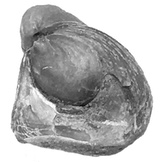Bryozoan Growth Forms
Although bryozoans often grow in a variety of forms, some typically grow in a particular way, and this can be a useful starting point for identification. In modern bryozoans, colony growth form is often influenced by the environment in which bryozoans live. As a result, a single species of bryozoan may grow into different forms depending on its environment, and a single environment may include many species with similar growth forms.
Colony types can be grouped broadly into those that are erect, those that extend vertically into the water column from a relatively small encrusting base, and those that are non-erect, which may have a broad base of attachment or which may not extend upward into the water column. Listed here are the colony forms that can be found in bryozoans of the type Cincinnatian.
Erect colony types
Ramose or dendroid colonies are erect branching colonies, in which the branches are roughly circular in cross section. Zooids are generally budded from the vertical walls of other zooids. Most of those in the type Cincinnatian are solid ramose, but some are hollow ramose, in which zooids bud from a cylindrical axial wall. Anastomosing colonies are similar to ramose colonies, but branches may rejoin. Articulate colonies occur in some cryptostomes and are characterized by branches joined by non-calcified cuticular material, which is generally not fossilized.
Frondose colonies are erect and have branches that are flattened like leaves. Zooids are budded from the vertical walls of other zooids. Frondose and bifoliate colonies are externally similar in that they both have leaflike shapes.
Bifoliate colonies are erect and often leaf-shaped. Zooids are arranged back-to-back and are budded off of a median wall that separates the opposing sets of zooids.
Fenestrate colonies are erect and have generally flattened branches that form a reticulate pattern characterized by many open holes (fenestrae) in the branches.
Non-erect colony types
Encrusting colonies are ones in which most zooids are attached by their basal wall to an external substrate, such as a shell, a cobble, or even another bryozoan.
Hemispherical colonies have roughly hemispherical shapes and in which zooids bud from the encrusting colony wall, from the vertical walls of other zooids, or from intracolony overgrowths.
Massive colonies are similar to hemispherical colonies in how zooids bud, but the colony has an overall irregular shape rather than a hemispherical one.
References
Boardman, R.S., A.H. Cheetham, D.B. Blake, J. Utgaard, O.L. Karklins, P.L. Cook, P.A. Sandberg, G. Lutaud, and T.S. Wood, 1983. Treatise on Invertebrate Paleontology, Part G: Bryozoa. Volume 1: Introduction, Order Cystoporata, Order Cryptostomata. Boulder, Colorado and Lawrence, Kansas: Geological Society of America and The University of Kansas. 625 p.

